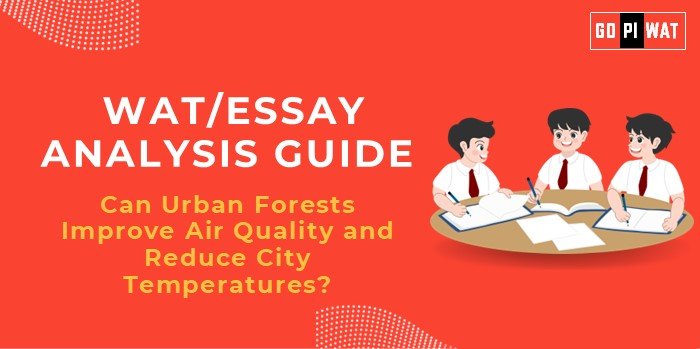📋 Written Ability Test (WAT) Analysis Guide: Can Urban Forests Improve Air Quality and Reduce City Temperatures?
🌍 Understanding the Topic’s Importance
Urban forests address critical environmental issues, including pollution and urban heat islands (UHIs). Their role aligns with B-school themes like sustainability and strategic policy development.
🕒 Effective Planning and Writing
Time Allocation (30 minutes):
- Planning: 5 minutes.
- Writing: 20 minutes.
- Reviewing: 5 minutes.
- Contrast Approach:
“While urbanization accelerates city temperatures, urban forests offer a natural countermeasure, combating air pollution and heat through cost-effective interventions.” - Solution-Based Approach:
“Amid rising urban pollution, urban forests emerge as a critical solution, combining environmental and social benefits.”
📊 Structuring the Essay Body
Achievements
Urban forests have proven effective in cities like Singapore, where they reduced particulate matter by 30%.
Challenges with Comparative Analysis
Dense Indian cities struggle with space constraints, unlike Nordic countries with established green corridors.
Future Outlook
With advancements in vertical gardening and urban planning, urban forests can become central to city ecosystems.
✅ Concluding Effectively
- Balanced Conclusion:
“Urban forests provide measurable environmental benefits but need cohesive policy support and citizen participation for sustained impact.” - Global Comparison Conclusion:
“Drawing lessons from cities like Singapore and Tokyo, Indian urban centers can replicate and adapt urban forestry solutions to local challenges.”
🔑 Recommendations for Sustainable Progress
- Integrate urban forestry into smart city missions.
- Incentivize rooftop and vertical gardens.
- Foster partnerships with environmental NGOs and corporates.
📝 Sample Short Essays
Balanced Perspective (100 words)
Urban forests reduce air pollution and city temperatures, providing a sustainable solution for urban challenges. However, achieving substantial impact requires tackling challenges like space constraints and high costs. Global examples like Singapore highlight their transformative potential, but Indian cities must adapt these models to local conditions, emphasizing community involvement and technological integration.
Solution-Oriented (100 words)
Urban forests mitigate pollution and heat through natural processes. Cities like Tokyo demonstrate innovative approaches, such as compact urban woodlands. To replicate these benefits, Indian cities can explore rooftop greening and vertical gardens, addressing space and maintenance constraints. Policymakers must prioritize green infrastructure as a core urban development strategy, ensuring long-term sustainability.
Global Comparison (100 words)
Urban forests’ success in cooling and pollution reduction is evident in cities like Singapore and Tokyo. These examples underscore the importance of strategic planning and public-private collaboration. Indian cities, grappling with dense populations and pollution, can adopt tailored strategies to integrate green cover, leveraging lessons from these global pioneers to enhance urban resilience.


